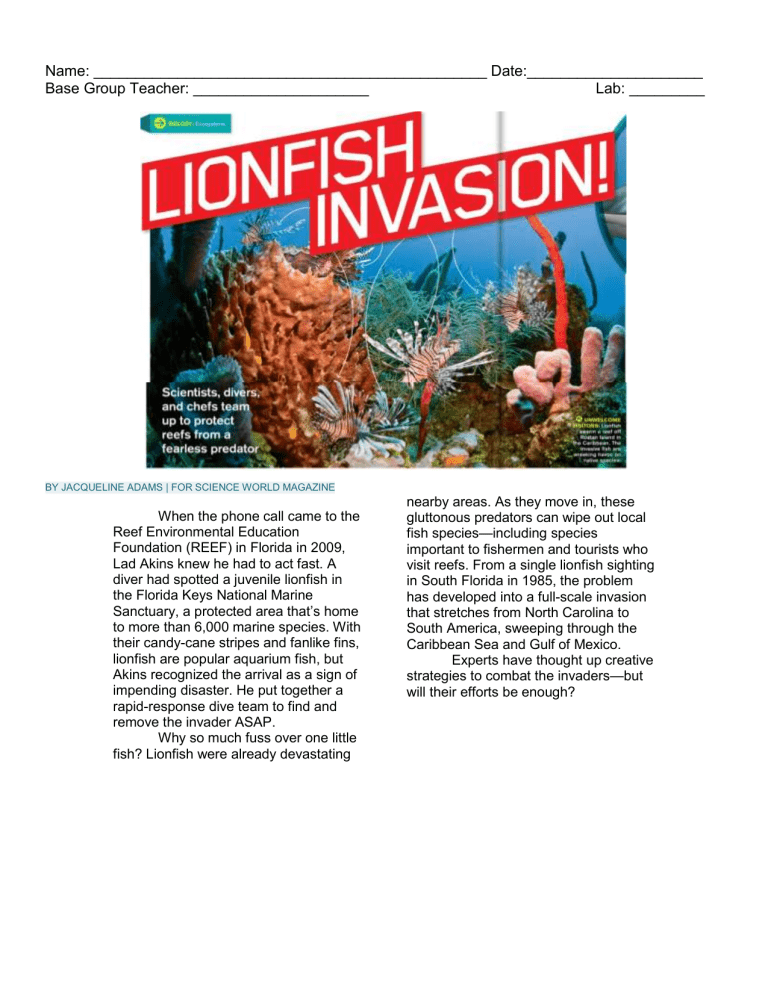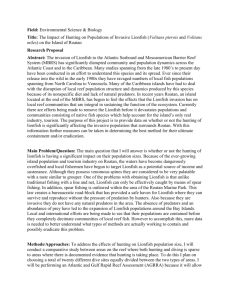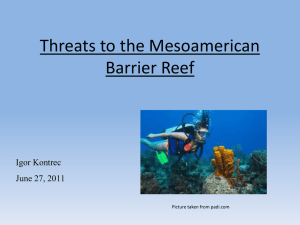Lion Fish Invasion!

Name: _______________________________________________ Date:_____________________
Base Group Teacher: _____________________ Lab: _________
BY JACQUELINE ADAMS | FOR SCIENCE WORLD MAGAZINE
When the phone call came to the
Reef Environmental Education
Foundation (REEF) in Florida in 2009,
Lad Akins knew he had to act fast. A diver had spotted a juvenile lionfish in the Florida Keys National Marine
Sanctuary, a protected area that’s home to more than 6,000 marine species. With their candy-cane stripes and fanlike fins, lionfish are popular aquarium fish, but
Akins recognized the arrival as a sign of impending disaster. He put together a rapid-response dive team to find and remove the invader ASAP.
Why so much fuss over one little fish? Lionfish were already devastating nearby areas. As they move in, these gluttonous predators can wipe out local fish species —including species important to fishermen and tourists who visit reefs. From a single lionfish sighting in South Florida in 1985, the problem has developed into a full-scale invasion that stretches from North Carolina to
South America, sweeping through the
Caribbean Sea and Gulf of Mexico.
Experts have thought up creative strategies to combat the invaders —but will their efforts be enough?
Fearless Predators
The natural habitat of lionfish is on the other side of the planet, in the
Pacific and Indian oceans. But many lionfish were imported to the U.S. as aquarium fish. In the 1980s, researchers believe, pet owners began releasing unwanted lionfish into the Atlantic
Ocean. There, the invasive species made itself at home. By the time divers discovered established populations of lionfish off the coast of North Carolina in
2000 —only 15 years after the first sighting —it was too late to stop the damage.
These deceptively delicatelooking fish are fearless predators. They stalk their prey, spread their fins to corner it, and then swallow it whole — even if i t’s half their body length. Even worse for native species: Lionfish keep hunting even when their bellies are full.
When James Morris, a marine ecologist at the National Oceanic and
Atmospheric Administration (NOAA), dissected invasive lionfish, he saw that they were obese. “We’ve dissected lionfish with over 20 prey items in their stomach,” he says. “They’re feasting on our native species and are full of fat.”
Other predators don’t want to mess with lionfish, which have venomous spines that deliver a painful sting. Their bright coloring —a feature of many venomous creatures —warns potential predators that the meal won’t be worth the pain. In a lab study, Morris found that even when larger predators were deprived of food, they wouldn’t go near a juvenile lionfish. And the striped invaders seem to know it. “Lionfish are very bold,” says Akins. “They tend not to pay much attention to any potential predator, whether that is another fish, or a shark, or an eel.”
In the Pacific and Indian oceans, lionfish live with a different mix of species that can coexist with them. But
Atlantic and Caribbean species were blindsided by the invasion. A recent study in the Bahamas showed that in only two years, native fish populations plummeted an average of 65 percent in areas where lionfish had moved in.
“In terms of the type of impacts they can cause,” says Morris, “lionfish can be compared to an oil spill.”
Fighting the Invaders
Despite the damage they can cause, Akins can’t help but admire lionfish for their beauty and amazing hunting strategies. “But they belong in their native range,” he says. “It’s a shame they’re in an area where they don’t belong, and in order to protect the fish that do belong, we have to take the lionfish out.”
That’s why REEF and NOAA developed a plan seven months before the first lionfish appeared in the Florida
Keys sanctuary. They hung signs in dive shops and on boats, telling divers how to report sightings. When that call came in 2009, Akins and four other divers headed to the reef and quickly captured the invader.
This rapid-response strategy worked only for a while, because the numbers of lionfish became too great. Now Akins trains divers to kill the fish on sight. “We have teams out there all the time,” he says. “Where divers are able to go, and they are actively removing lionfish, we see very few.”
The problem is that lionfish spend most of their time at depths of up to 300 meters
(984 feet) —much deeper than people can dive —and have invaded most of the coastal
Atlantic Ocean. Researchers are attempting to develop a trap that will capture lionfish from deeper areas without disturbing other fish. But until then, divers are coming up with ways to curb the invasion closer to shore.
Derbies and Dinners
In 2009, the Bahamas held its first-ever lionfish derby. Teams of divers and snorkelers competed to catch the most lionfish. Using nets and pole spears, they bagged 1,408 invaders in one day. The event was such a hit that lionfish derbies are now held throughout the Caribbean.
Another control strategy: If you can’t beat ’em, eat ’em. Restaurants are adding lionfish to the menu, and ad campaigns are encouraging people to dig in. Akins, who describes the taste as
“very mild—a delicate flavor,” has even co-authored a lionfish cookbook complete with instructions on how to catch the fish and safely remove the venomous spines.
Some divers are even trying to train local sharks to hunt the invaders.
They leave lionfish they’ve injured or killed for the sharks, in the hopes that the sharks will acquire a taste for the fish.
Unfortunately, though, no one believes lionfish will be eradicated from the Atlantic.
“The best we can hope for,” says
Morris, “is that we create management areas in which lionfish are controlled.”
Still, everyone can help prevent similar invasions by other non-native pets. “Don’t release your invader,” says
Morris





